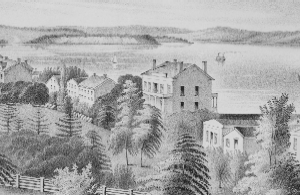Aurora Inn facts for kids
Quick facts for kids |
|
|
Aurora Inn
|
|
|
U.S. Historic district
Contributing property |
|

Aurora Inn at Night
|
|
| Location | Aurora, New York |
|---|---|
| Built | 1793 |
| Architect | Davis, A.J. & Downing, A.J.; Et al. |
| Architectural style | Mid 19th Century Revival, Early Republic, Late Victorian |
| Part of | Aurora Village-Wells College Historic District (ID80002595) |
| Designated CP | November 19, 1980 |
The Aurora Inn is a historic building located in Aurora, Cayuga County, New York. It was built in 1833 for Edwin B. Morgan. He was a local businessman who worked with trade and shipping on Cayuga Lake. This lake is one of the beautiful Finger Lakes in New York.
Aurora was an important port in the past. Goods were shipped from here up the lake and through the Erie Canal. This allowed them to reach big cities like New York City. The Aurora Inn, originally called Aurora House, was built right on the shores of Cayuga Lake. It is now part of a special historic area called the Aurora Village-Wells College Historic District. This district was added to the National Register of Historic Places on November 19, 1980.
History of the Aurora Inn
Edwin B. Morgan ran a store with his brothers. He became very wealthy from trade and shipping. His businesses connected Aurora to bigger markets through Cayuga Lake and the Erie Canal. Aurora was a busy port in the mid-1800s.
Morgan also invested in famous companies. He was an early investor in The New York Times newspaper. He also invested in American Express, which was started by his friend Henry Wells. Morgan even helped lead Wells Fargo & Company, a company that helped people in California. Morgan's old home, the E. B. Morgan House, is also in the historic district. It's now a fancy bed and breakfast.
During the busy 1800s, the Aurora Inn was a popular place to stay. Travelers arrived by stagecoach, canal boat, and train. A local newspaper wrote about the Inn soon after it opened. The article praised its "neatness and order" and how well travelers were treated. The writer also loved the Inn's "uninterrupted view of the water scenery." They said its elegance was "scarcely surpassed" by bigger hotels.
In 1888, a fire destroyed the main building at Wells College. Many students needed a place to live. They stayed at the Aurora Inn for a while. During this time, they even renamed it the Wayside Inn.
Another fire happened on February 27, 1919. It burned down Aurora's small business area. The fire reached the south side of the Inn's roof. Wells College President Kerr Duncan McMillan bravely climbed onto the roof. He used buckets of water from the village fire brigade to put out the flames. Today, you can still see charred beams under the roof. They are a reminder of how close the Inn came to being destroyed.
Since the early 1900s, the Inn has been a favorite spot. Students and families from Wells College, Cornell University, and other nearby schools enjoyed visiting. In 1943, the Aurora Inn was given to Wells College. In the 1960s, when more students enrolled, the Inn was even used as a temporary dorm.
Later, the Aurora Inn faced financial challenges. It had to close several times. The most recent closure was in October 2000.
Aurora Inn Today
In 2001, the Aurora Foundation began a big project. This group is a partnership between Wells College and the Pleasant Rowland Foundation. They decided to renovate the Aurora Inn. Their goal was to make it a great place for lodging, dining, and special events.
The renovation finished in 2003. The Aurora Inn now has 10 guest rooms. It also has a new restaurant with outdoor dining by the lake. There's a banquet room for special occasions too. A stone terrace, lawns, and gardens were added. These connect the Inn to the beautiful shores of Cayuga Lake.
The team that renovated the Inn worked hard. They included Pleasant Rowland and others. They tried to reuse original fireplaces, woodwork, and other details. If they couldn't reuse them, they made new ones that looked just like the old ones. They used old photos to guide how the outside should look. The inside was updated to be modern and comfortable for travelers.
The public rooms at the Aurora Inn are decorated beautifully. You can see antiques, Oriental rugs, and comfy furniture. There's also a collection of old and new art. The Aurora Inn restaurant serves breakfast, lunch, and dinner every day. You can enjoy outdoor dining on the porch or veranda when the weather is nice.
In the early 1840s, Willem D. Eagles bought the Aurora Inn. He asked his uncle, John Eagles, to manage it. Today, oil paintings of William Eagles and his wife Nancy hang above fireplaces in the reception area. Portraits of John Eagles and his wife are in the dining room and bar. These paintings were restored and were created in the 1800s by artist Charles Loring Elliott.







